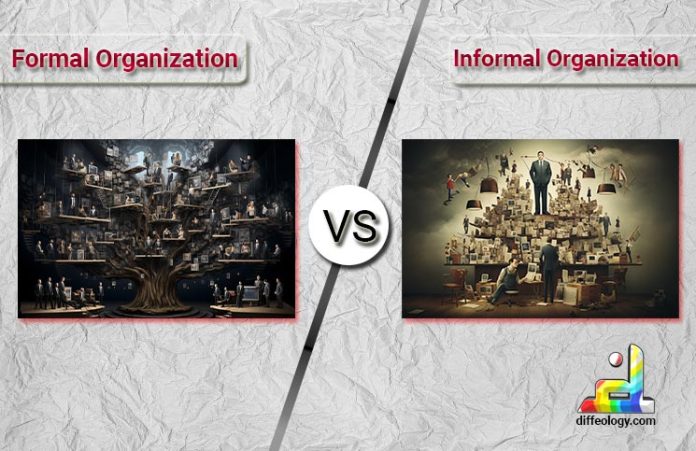An organization is a group of individuals who work together to achieve certain goals. There are two sorts of organizational structures: formal organizational structures and informal organizational structures. A formal relationship is formed between two or more people to pursue a similar goal. Also, there is a structure of authority. You can say this organization is a formal one. There are two types of organizations, formal and informal. But what is the Difference Between Formal and Informal Organization?
On the other hand, an informal organization is developed beneath a formal organization as a system of social relationships. They emerge when individuals in an organization meet, engage, and associate with one another. In this essay extract, we will look at the key distinctions between formal and informal organizational structures.
Comparison Table “Formal Vs. Informal Organization”
| What Is It: | Formal organization is a style of organization in which each member’s work is explicitly defined and whose power, duty, and accountability are established. | Informal communication refers to an organization developed inside a formal organization as a network of interpersonal relationships when individuals engage with one another. |
| Creation: | Top management did this on purpose. | Members on their own initiative. |
| Main Purpose: | To accomplish the organization’s ultimate goal. | To meet their social and psychological requirements. |
| Nature: | It is stable and lasts a long time. | Instability. |
| Communication: | Official communication. | Gossip. |
| Mechanism of control: | Principles and Rules. | Values, norms, and beliefs. |
| Concentrate on: | Work Performance. | Relationship between people. |
| Authority: | Members are linked together through a hierarchical structure. | Every member is equal. |
| Size: | Large One. | Small one. |
Difference Between Formal and Informal Organization
We’ve all been a part of some kind of group. And depending on how the group conducted its operations, it may be either informal or formal. There are several sorts of organizations. People make some of them for profit, but others are available for social causes. Formal and informal groups differ in rules and authority. Knowing the difference may help people make these decisions. In this post, we’ll look at the Difference Between Formal and Informal Organization.
Formal Organization
A formal organization is a collection of individuals who have a formal connection, written regulations and procedures, and a shared objective. Compliance is the foundation of formal organizations. As a result, there is an authority structure.
Also Read: Difference Between Entrepreneur and Businessman
A formal organization’s mission is to achieve a set of objectives. This might range from profit-making to giving education or medical support to a group of people to govern. Each member knows his duty in these situations, as delegated by those in charge. Accountability is also a key aspect of formal organizations. So, failing to complete assigned responsibilities results in repercussions.
Formal organizations are classified as line & staff, line, matrix, project management, and functional organizations.
What Distinguishes a Formal Organization?
- Rules and regulations- Formal organizations have a set of rules and regulations that everyone must observe.
- Definite interrelationships- Employees and customers in the formal organizations have mutual and definite interrelationships. It is possible through the hierarchy.
- Stability- Because they must pursue a certain aim, formal organizations provide steady working circumstances.
- Division of labor- Formal organizations has a division of labor through designated departments. This improves an entity’s structure and seamless operation.
Organizations That are Informal
An organization is formed when a group of people interacts, form connections, and form an entity through mutual interactions. Informal groups, like formal organizations, have a structure that is determined by the members’ relationships, norms, and affiliations. Members also cooperate to attain the intended objective depending on their strengths and competencies.
What Distinguishes an Informal Organization?
- Non-formal communication channels- The majority of informal organizations have their own communication channels. And, in the majority of situations, they are informal. For example, a phone call would serve to transfer communication from the lowest tier to the highest rank.
- No rules and regulations- An informal organization is operated based on people’s personal relationships.
- Instability- Informal organizations are prone to instability. As a result, individuals are free to go with few restrictions.
Formal and Informal Organizational Similarities
Both bring together a group of individuals who have a shared aim.
Organizational Difference Between Formal and Informal Organization
Definition
A formal organization is a collection of individuals who have a formal connection, written regulations and procedures in place, and a shared aim. An informal organization, on the other hand, is one that forms when a group of individuals engage, make connections, and form an entity via mutual interactions.
Purpose
In order to achieve a certain set of objectives, funds are available in the formal organizations. Informal groups, on the other hand, have aims to achieve, although they are not necessarily specified.
Authority
While formal organizations have a clearly defined and recorded hierarchy of power, informal groups do not.
Also Read: Difference Between Budget and Forecast
Communications
The chain of command defines the communication arrangements of formal organizations. Informal organizations, on the other hand, lack established communication routes, which means that a person at the bottom of the hierarchy may speak directly with someone at the top.
Creation
A team of managers creates formal organizations on purpose. A few people make the Informal organizations.
Stability
Formal organizations have a well-thought-out framework in place to maintain stability. Informal organizations, on the other hand, are not stable.
Governance
A collection of rules and regulations regulate formal organizations. Informal groups, on the other hand, are what people base on values, conventions, and beliefs.
The primary emphasis
While formal organizations are concerned with job performance, informal organizations are primarily concerned with interpersonal ties.
Key Difference Between Formal and Informal Organization
The Difference Between Formal and Informal Organization is what you will see on the following grounds:
- A formal organization is one in which each member knows his role, and in which power, responsibility, and accountability are fixed. When individuals engage with one another, an informal organization forms inside the formal organization as a network of interpersonal relationships.
- Top management creates a formal structure on purpose. Members of an informal group, on the other hand, establish it spontaneously.
- Achieving the firm’s goals is the aim of Formal organization. In contrast, an informal structure is available to meet their social and psychological requirements.
- Formal organization is of a permanent character; it lasts a long period. Informal organization, on the other hand, is of a transient character.
- The formal organization adheres to an official communication. It means that communication routes are pre-defined. In contrast to informal organizations, communication may flow either way.
- Every member of a formal organization has to observe the rules and regulations. Norms, values, and beliefs, in contrast to informal communication, serve as a control mechanism.
- In a formal organization, the emphasis is on job performance. Nut in an informal organization, interpersonal communication is what people consider.
- The size of a formal organization continues to grow, but the size of an informal group remains modest.
- An organization’s hierarchical structure binds all its members. Informal organizations don’t have a hierarchy.
Difference Between Formal and Informal Organization Summary
A formal organization is the polar opposite of an informal organization. The primary difference between these two is that all members of a formal organization follow a chain of command, while members of an informal group do not. Furthermore, the former has a superior-subordinate connection (status relationship), but the later does not since all members are equal (role relationship).
A formal organization is a collection of individuals who have a formal connection, written regulations and procedures in place, and a shared aim. Formal organizations are available to achieve a specific goal. As a result, they tend to outperform other forms of organizations. An informal organization, on the other hand, is one that forms when a group of individuals engage, make connections, and form an entity via mutual interactions. They have objectives to achieve, but they are not usually specified. So, now you know the Difference Between Formal and Informal Organization.



